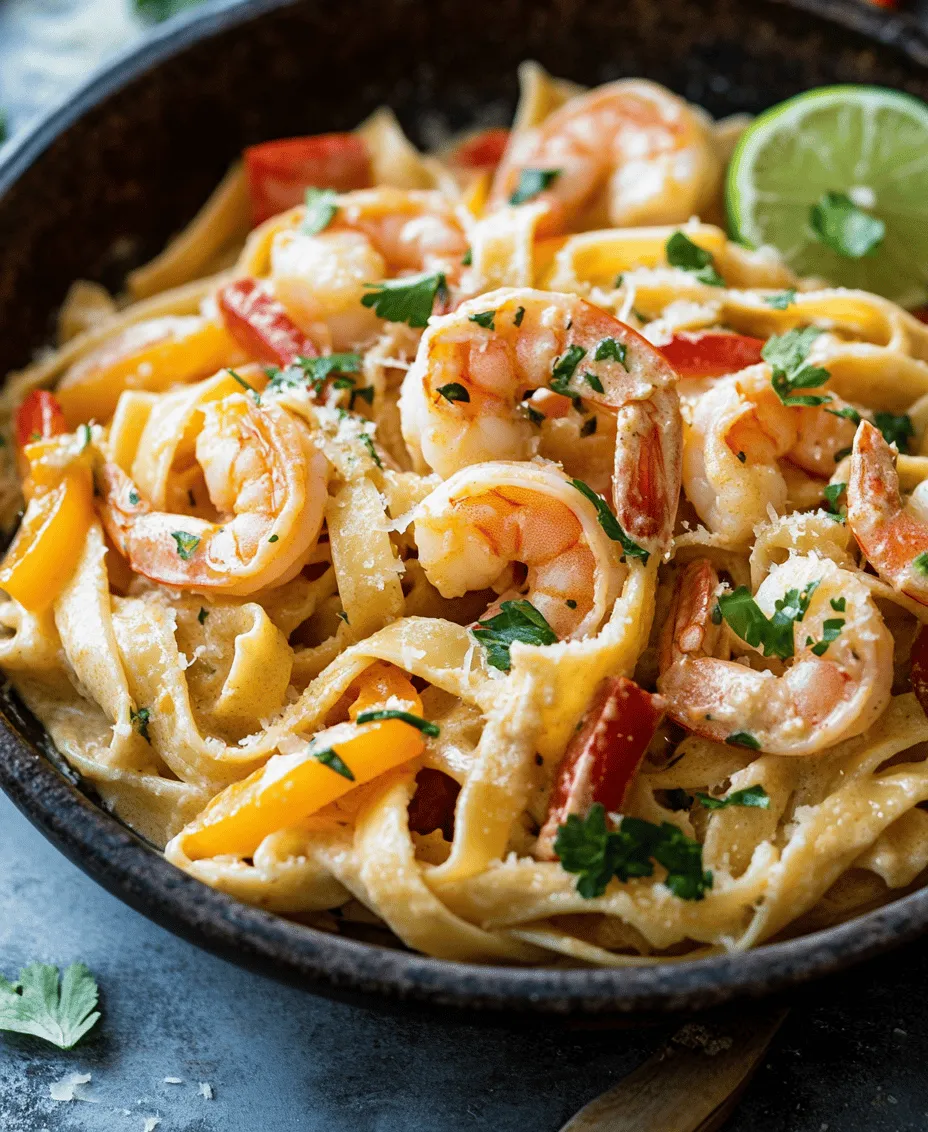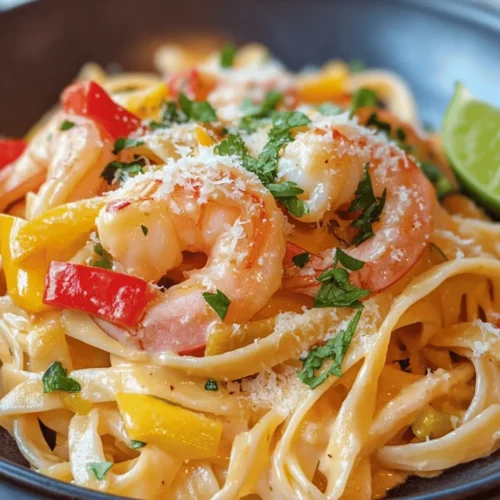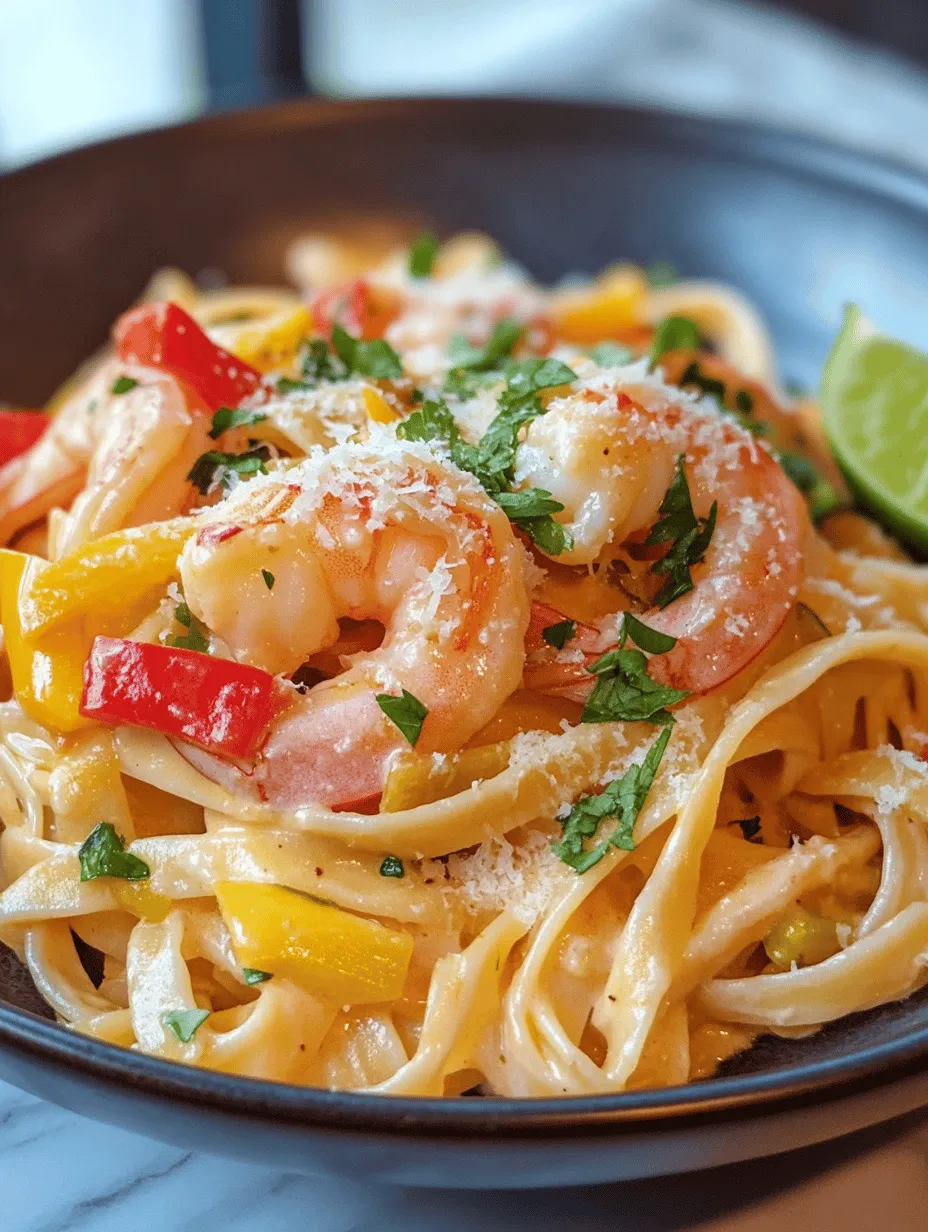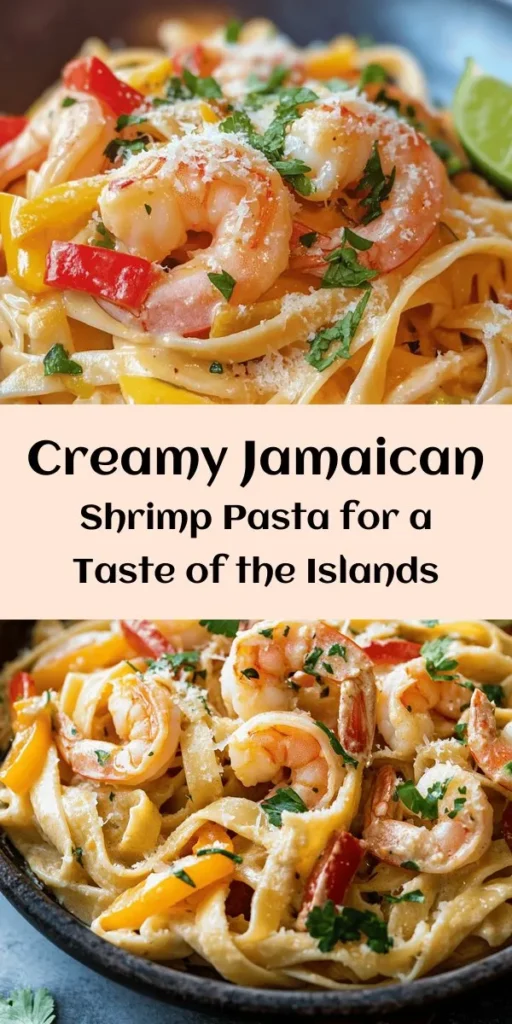Introduction to Jamaican Shrimp Pasta: A Creamy Delight
Jamaican cuisine is a vibrant tapestry of flavors, colors, and aromas, reflecting the island’s rich cultural heritage and diverse influences. Known for its bold spices, fresh ingredients, and an emphasis on both sweet and savory notes, Jamaican food has garnered a global following. Among the many delightful dishes that emerged from this culinary landscape is Jamaican Shrimp Pasta—a dish that beautifully marries the creamy textures of traditional pasta with the zesty, spicy characteristics of Jamaican cooking.
Jamaican Shrimp Pasta is not just a meal; it’s an experience. This dish showcases succulent shrimp sautéed to perfection, enveloped in a rich, creamy sauce infused with the unmistakable heat of jerk seasoning. Whether you’re looking to impress guests at a family gathering, whip up a comforting meal for your loved ones, or simply explore new culinary horizons, this dish promises to deliver a satisfying and flavorful experience. The combination of creaminess and spice makes it versatile enough for both casual weeknight dinners and festive occasions alike.
Exploring the Ingredients of Jamaican Shrimp Pasta
Creating the perfect Jamaican Shrimp Pasta begins with understanding the ingredients that contribute to its unique flavor profile. Each element plays a vital role in crafting a dish that is both delicious and satisfying.
Fettuccine Pasta: The Perfect Choice for Creamy Sauces
When it comes to pasta, fettuccine is an excellent choice for this dish due to its broad, flat shape, which allows it to hold onto creamy sauces beautifully. The texture of fettuccine complements the rich sauce, ensuring that every bite is a harmonious blend of flavors. Cooking the pasta to an al dente texture is crucial, as it maintains a slight bite and prevents it from becoming mushy when combined with the sauce.
Shrimp: Nutritional Benefits and Flavor Profile
Shrimp is the star protein in this dish. Not only is it delicious, but it’s also packed with nutritional benefits. Shrimp is low in calories yet high in protein, making it a great option for those looking to enjoy a hearty meal without excessive calories. Its mild flavor allows it to absorb the spices and seasonings, making it a perfect match for the bold jerk seasoning used in this recipe. Additionally, shrimp cooks quickly, making it an ideal protein choice for a weeknight dinner.
Olive Oil and Unsalted Butter: The Foundation of a Rich, Flavorful Base
A combination of olive oil and unsalted butter serves as the foundation for the dish, creating a rich and flavorful base. Olive oil adds a fruity, slightly peppery taste, while butter contributes a creamy richness that enhances the overall mouthfeel of the sauce. This combination also helps in sautéing the shrimp and vegetables to perfection, ensuring they are cooked evenly and infused with flavor.
Garlic and Onion: Aromatics that Enhance the Dish’s Depth
Garlic and onion are essential aromatics in many cuisines, and Jamaican Shrimp Pasta is no exception. They add layers of flavor and aroma, creating a savory foundation for the dish. When sautéed, garlic becomes sweet and mellow, while onion adds a hint of sweetness and depth that complements the other ingredients beautifully.
Bell Pepper: Adding Color and Crunch
Bell peppers not only introduce vibrant color to the dish but also provide a satisfying crunch. Their natural sweetness balances the heat from the jerk seasoning, creating a well-rounded flavor profile. When cooked, bell peppers soften slightly but retain enough texture to add contrast to the creamy sauce.
Jamaican Jerk Seasoning: The Star Ingredient
At the heart of Jamaican Shrimp Pasta is the bold and aromatic Jamaican jerk seasoning. This spice blend typically consists of allspice, thyme, scallions, nutmeg, cinnamon, and Scotch bonnet peppers, among other ingredients. The result is a complex flavor profile that is both spicy and fragrant. The jerk seasoning not only elevates the shrimp but also infuses the entire dish with that signature Caribbean flair that makes Jamaican cuisine so beloved.
Coconut Milk and Heavy Cream: Creating a Luxurious, Creamy Sauce
The creamy sauce in this dish is a luxurious blend of coconut milk and heavy cream. Coconut milk adds a hint of sweetness and a tropical essence that pairs beautifully with the jerk seasoning, while heavy cream contributes richness and a velvety texture. This combination results in a sauce that coats the pasta perfectly, ensuring each bite is indulgent and satisfying.
Parmesan Cheese: Adding a Savory Note
A sprinkle of freshly grated Parmesan cheese at the end adds a savory note to the dish, enhancing the overall flavor profile. The nuttiness of the cheese complements the richness of the sauce and ties all the flavors together beautifully.
Lime Juice: Brightening the Dish and Balancing Flavors
To balance the richness of the sauce, a squeeze of fresh lime juice is essential. The acidity of lime juice brightens the dish, cutting through the creaminess and enhancing the flavors of the shrimp and spices. It adds a fresh, zesty element that rounds out the dish beautifully.
Fresh Cilantro or Parsley: A Final Touch for Garnish and Freshness
Finally, a sprinkle of fresh cilantro or parsley adds a burst of color and freshness to the dish. Not only does it elevate the presentation, but it also adds a hint of herbal flavor that complements the boldness of the jerk seasoning and the creaminess of the sauce.
Step-by-Step Guide to Making Jamaican Shrimp Pasta
Now that we have explored the vibrant ingredients that make up Jamaican Shrimp Pasta, let’s dive into the step-by-step process of creating this delicious dish. Following these instructions will help you achieve the perfect balance of flavors and textures.
Cooking the Pasta: Importance of Al Dente Texture
1. Begin by boiling a large pot of salted water. The salt enhances the flavor of the pasta during cooking.
2. Once the water is boiling, add the fettuccine pasta and cook according to package instructions, usually around 8 to 10 minutes, until it reaches an al dente texture.
3. Al dente pasta should be slightly firm to the bite, as it will continue to cook when combined with the sauce.
4. Reserve a cup of pasta cooking water before draining the pasta. This starchy water can be used later to adjust the sauce’s consistency if needed.
Sautéing Shrimp: Techniques for Cooking Shrimp to Perfection
1. While the pasta is cooking, heat a large skillet over medium-high heat and add a tablespoon of olive oil and a tablespoon of unsalted butter.
2. Once the oil and butter are hot and shimmering, add the shrimp in a single layer. Make sure not to overcrowd the pan; you may need to do this in batches.
3. Season the shrimp with salt and a generous amount of Jamaican jerk seasoning. The seasoning will give the shrimp a beautiful color and flavor.
4. Sauté the shrimp for 2-3 minutes on each side until they turn pink and opaque. Be careful not to overcook them, as shrimp can become rubbery.
5. Once cooked, remove the shrimp from the skillet and set them aside on a plate.
Preparing the Sauce: Building Flavors Through Sautéing
1. In the same skillet, add a bit more olive oil and butter if needed. Reduce the heat to medium.
2. Add finely chopped onion and minced garlic. Sauté for about 2 minutes, or until the onion becomes translucent and the garlic is fragrant. Be careful not to burn the garlic, as it can turn bitter.
3. Next, add diced bell pepper and continue sautéing for another 2-3 minutes until the peppers have softened slightly.
Adding Seasoning & Liquids: The Role of Jamaican Jerk Seasoning
1. Once the vegetables are cooked, it’s time to build the sauce. Add a can of coconut milk and a splash of heavy cream to the skillet, stirring to combine.
2. Return the cooked shrimp to the skillet and sprinkle in some additional jerk seasoning to taste. Stir well to ensure the shrimp are coated in the creamy sauce.
Explanation of the Simmering Process for Sauce Thickening
1. Allow the sauce to simmer gently for about 5-7 minutes, stirring occasionally. This simmering process helps meld the flavors together and allows the sauce to thicken slightly.
2. If the sauce is too thick, you can add a splash of the reserved pasta cooking water until you reach your desired consistency. Remember, the sauce should be creamy and luscious but not overly thick.
As you follow these steps, your kitchen will be filled with enticing aromas reminiscent of a tropical getaway. The combination of creamy and spicy notes will have you eagerly anticipating the final dish. Stay tuned for the concluding steps, where we will add the finishing touches and serve this delightful Jamaican Shrimp Pasta!

Mixing in Cheese: The Science Behind Melting Cheese in Sauces
Incorporating cheese into your Jamaican Shrimp Pasta not only enhances the flavor profile but also contributes to a creamy and rich texture that elevates the entire dish. When it comes to melting cheese, understanding the science behind it can make a significant difference in achieving the perfect sauce.
Cheese contains proteins and fats, which when heated, undergo a transformation. The proteins denature, allowing them to bind with moisture and fat, resulting in a smooth and creamy sauce. To ensure that your cheese melts evenly and integrates seamlessly into the sauce, it’s essential to choose the right type of cheese. Aged cheeses like Parmesan or cheddar melt beautifully and add depth to the flavor. Avoid pre-grated cheeses as they often contain anti-caking agents that can prevent smooth melting. Instead, opt for freshly grated cheese to achieve the best results.
Ensuring a Smooth Integration of All Components
Once you’ve prepared the base of your sauce with coconut milk, spices, and aromatics, it’s time to integrate the cheese. To do this effectively, follow these steps:
1. Lower the Heat: After adding the coconut milk and letting it simmer, reduce the heat to low before introducing the cheese. High temperatures can cause the fats to separate, leading to a grainy texture.
2. Gradual Addition: Slowly sprinkle in the cheese while continuously stirring. This gradual method allows the cheese to melt uniformly and blend smoothly into the sauce.
3. Use a Whisk: For an ultra-smooth finish, consider using a whisk to incorporate the cheese fully. This tool helps break down any clumps and ensures a creamy consistency.
4. Taste and Adjust: Once the cheese has melted, taste your sauce. You may need to adjust the seasoning with salt, pepper, or additional spices to balance the flavors.
Combining Everything: Techniques for Perfect Pasta Coating
Achieving the ideal coating of your pasta with the sauce is crucial for delivering maximum flavor in each bite. Here are some techniques to ensure that your Jamaican Shrimp Pasta is perfectly dressed:
1. Cook Pasta Al Dente: Begin by cooking your pasta according to package instructions, but aim for al dente. This allows the pasta to maintain its shape and provides a firm texture that holds sauce better.
2. Reserve Pasta Water: Before draining your pasta, reserve a cup of the cooking water. This starchy water can be added to the sauce to help emulsify and create a silkier texture.
3. Toss in the Sauce: In a large skillet, combine the cooked shrimp with your creamy sauce over low heat. Add the drained pasta directly into the skillet. Use tongs to gently toss the pasta with the sauce, ensuring that every strand is evenly coated.
4. Add Reserved Water: If the sauce appears too thick, gradually add a little reserved pasta water until you reach your desired consistency. This will enhance the cohesiveness of the dish without diluting the flavor.
5. Final Touches: Allow the pasta to cook in the sauce for a minute or two. This step helps the flavors meld together and gives the pasta a chance to absorb some of the sauce.
Importance of Tossing Pasta with Sauce for Full Flavor Integration
The act of tossing pasta with the sauce is more than just a technique; it is essential for flavor integration. When you toss pasta in sauce, you create a harmonious blend where every bite offers a burst of flavor, thanks to the following reasons:
– Coating: Tossing ensures that every piece of pasta is coated with sauce, preventing any dry bites and ensuring a consistent taste throughout the dish.
– Heat Distribution: Tossing helps distribute the heat evenly, ensuring that the pasta and sauce are served warm, enhancing the overall dining experience.
– Flavor Absorption: Allowing the pasta to sit in the sauce for a brief moment allows the pasta to absorb the flavors, making every bite more enjoyable.
Serving Suggestions: Presentation Tips for an Appealing Dish
Presentation plays a vital role in enhancing the dining experience. Here are some tips to make your Jamaican Shrimp Pasta visually appealing:
1. Choose the Right Dish: Serve your pasta in a large, shallow bowl. This allows for ample surface area for the sauce and garnishes, making the dish look abundant.
2. Garnish Generously: Top your pasta with freshly chopped herbs, such as cilantro or parsley, for a pop of color. A sprinkle of red pepper flakes can add a touch of heat and visual contrast.
3. Add a Zest of Lime: A wedge of lime on the side not only adds a splash of color but also provides a burst of freshness when squeezed over the dish just before serving.
4. Cheese Shavings: For a final touch, finish off with some freshly grated cheese on top. This not only enhances the flavor but also creates an inviting look.
5. Serve with a Side Salad: Pair your Jamaican Shrimp Pasta with a light salad featuring tropical fruits such as mango or avocado. This adds freshness and balances the richness of the pasta.
Nutritional Benefits of Jamaican Shrimp Pasta
This dish doesn’t just satisfy your taste buds; it also offers numerous health benefits. Let’s explore the nutritional components of Jamaican Shrimp Pasta.
Overview of Health Benefits Associated with the Main Ingredients
1. Shrimp as a Source of Lean Protein: Shrimp is an excellent source of high-quality protein, essential for muscle repair and growth. It is low in calories and contains important nutrients such as selenium, vitamin B12, and iodine, which support overall health.
2. The Role of Coconut Milk in Providing Healthy Fats: Coconut milk is rich in medium-chain triglycerides (MCTs), a type of fat that may support weight management and provide quick energy. It also contains lauric acid, which has antimicrobial properties.
3. Nutritional Value of Vegetables Used in the Recipe: The vegetables in the recipe, such as bell peppers and onions, are packed with vitamins, minerals, and antioxidants. They contribute to overall health by supporting the immune system and promoting good digestion.
4. Balanced Meal Aspect: This dish provides a well-rounded meal, combining carbohydrates (pasta), proteins (shrimp), and healthy fats (coconut milk), making it a nourishing option for any time of day.
Cultural Significance of Jamaican Cuisine
Exploring Jamaican Shrimp Pasta also offers a glimpse into the rich cultural tapestry of Jamaican cuisine.
Insights Into Jamaican Culinary Traditions
Jamaican cuisine is a vibrant blend of flavors and techniques influenced by various cultures, including African, Indian, Chinese, and European. Each influence contributes to the bold and diverse palate that defines the island’s food.
The Influence of Caribbean Spices and Herbs on Global Cuisine
Jamaican dishes are characterized by their use of spices like allspice, thyme, and scotch bonnet peppers. These ingredients not only enhance the flavor but have also made their way into international dishes, showcasing the global impact of Caribbean cuisine.
How Jamaican Shrimp Pasta Embodies the Spirit of Fusion Cooking
Jamaican Shrimp Pasta is a prime example of fusion cooking, bringing together traditional Jamaican flavors with a beloved Italian staple. This dish embodies the spirit of creativity and cultural exchange, making it a unique addition to any table.
Versatility of Jamaican Shrimp Pasta
One of the best aspects of Jamaican Shrimp Pasta is its versatility. Here are some ways to adapt the dish to accommodate various dietary preferences:
1. Variations to Accommodate Dietary Preferences: If you have friends or family with specific dietary restrictions, consider swapping out shrimp for other proteins like chicken, tofu, or even chickpeas for a plant-based option.
2. Options for Gluten-Free Pasta: For those avoiding gluten, gluten-free pasta made from rice or lentils works beautifully and ensures everyone can enjoy this delightful dish.
3. Adapting Spice Levels for Different Palates: Feel free to adjust the spice levels based on personal preference. If you prefer a milder dish, reduce the amount of scotch bonnet pepper or use a milder chili pepper.
4. Ideas for Additional Vegetables or Toppings: Incorporating seasonal vegetables such as zucchini, spinach, or cherry tomatoes can add extra nutrients and vibrant colors to your dish.
Conclusion: Enjoying Jamaican Shrimp Pasta
In conclusion, Jamaican Shrimp Pasta is a delightful dish that combines rich, creamy flavors with the vibrant influences of Caribbean cuisine. The careful blending of spices, fresh ingredients, and the satisfaction of a well-cooked pasta dish make it a perfect choice for family dinners or entertaining guests.
The joy of creating this dish lies not only in the preparation but also in sharing it with loved ones. As you savor each bite, you’ll appreciate the unique taste of Jamaican culture and the delightful fusion of flavors that this creamy pasta brings to your table. So gather your ingredients, unleash your culinary creativity, and enjoy the experience of cooking and sharing this vibrant dish with those you care about. Embrace the flavors of Jamaica and let your taste buds take a delicious journey!



